Innovations in Sensor-Based Systems and Sustainable Energy Solutions for Smart Agriculture: A Review
Abstract
1. Introduction
1.1. Background and Motivation
1.2. Objectives of the Study
- Summarize the latest developments in smart agriculture technologies.
- Highlight the growing role of artificial intelligence and machine learning in agricultural processes.
- Discuss the benefits and limitations of various smart agriculture systems.
- Provide insights into future research directions and potential applications of these technologies.
1.3. Main Contributions
- Comprehensive Review: Provides an in-depth review of recent advancements in IoT-based sensors, wireless communication protocols, energy-harvesting methods, and automated irrigation and fertilization systems.
- AI and ML Integration: Emphasizes the growing role of artificial intelligence and machine learning in monitoring and managing various agricultural processes, including crop health assessment, pest control, and soil and water resource optimization.
- Technological Insights: Discusses the benefits and limitations of various smart agriculture systems, offering valuable insights for researchers and practitioners.
- Future Directions: Identifies potential future research directions and applications of smart agriculture technologies, contributing to the ongoing development of sustainable and efficient farming practices.
1.4. Various Wireless Nodes
1.5. Various Agricultural Sensors
1.6. List of Wireless Communication Protocols (WCP)
1.7. Structure of the Paper
2. IoT Applications in Agriculture
2.1. Overview of IoT in Agriculture
2.2. Smart Irrigation System
2.3. Smart Fertilization System
2.4. Soil and Crop Monitoring
2.5. Livestock Health Tracking
2.6. Early Disease Detection and Pest Control System
2.7. Decision-Making Systems
3. Some Parameters Associated with Smart Agriculture
3.1. Soil Moisture
3.2. Soil pH Level
3.3. Yield Monitoring
3.4. Sensing of the Weather and Environment
3.5. Sensing Micronutrients in Soil
3.6. Remote Sensing for Smart Agriculture
3.6.1. Hyperspectral Imaging
3.6.2. Multispectral Imaging
3.6.3. RGB Imaging
3.6.4. Measurements of Sunlight-Induced Fluorescence
3.6.5. Thermal Imaging
4. Identification of Harmful Insects and Diseases
4.1. Crops Contaminated by Insects
4.2. Crop Inspection
5. Some Additional Systems Associated with Monitoring and Control
6. Energy-Harvesting Approaches in Agriculture
6.1. Solar Energy
6.2. Wind Energy
6.3. Vibration Energy
6.4. Water Flow Energy
6.5. Microbial Fuel Cell (MFC) Energy
7. Differences in Methods for Field and Greenhouse Cultivation
7.1. Field Cultivation
7.2. Greenhouse Cultivation
7.3. Comparison
8. Future Directions
9. Conclusions
Funding
Data Availability Statement
Conflicts of Interest
References
- Balasubramaniam, S.; Joe, C.V.; Prasanth, A.; Kumar, K.S. Computer Vision Systems in Livestock Farming, Poultry Farming, and Fish Farming: Applications, Use Cases, and Research Directions. In Computer Vision in Smart Agriculture and Crop Management; Wiley: Hoboken, NJ, USA, 2025; pp. 221–258. [Google Scholar]
- Ghazal, S.; Munir, A.; Qureshi, W.S. Computer vision in smart agriculture and precision farming: Techniques and applications. Artif. Intell. Agric. 2024, 13, 64–83. [Google Scholar] [CrossRef]
- ur Rehman, W.; Koondhar, M.A.; Afridi, S.K.; Albasha, L.; Smaili, I.H.; Touti, E.; Aoudia, M.; Zahrouni, W.; Mahariq, I.; Ahmed, M.M.R. The Role of 5G Network in Revolutionizing Agriculture for Sustainable Development: A Comprehensive Review. Energy Nexus 2025, 17, 100368. [Google Scholar] [CrossRef]
- Abinaya, M.; Vadivu, G.; Prasanth, A.; Dhivyasri, G. Role of Big Data Analytics in Intelligent Agriculture. In Computational Intelligence in Internet of Agricultural Things; Springer Nature Switzerland: Cham, Switzerland, 2024; pp. 19–48. [Google Scholar]
- Ahmed, N.; Shakoor, N. Advancing Agriculture through IoT, Big Data, and AI: A Review of Smart Technologies Enabling Sustainability. Smart Agric. Technol. 2025, 10, 100848. [Google Scholar] [CrossRef]
- Kumar, A.; Yadav, R.; Patel, P. Big Data and AI for Sustainable Smart Agriculture: Trends and Future Directions. Smart Agric. Syst. 2025, 10, 100–115. [Google Scholar]
- Li, W.; Awais, M.; Ru, W.; Shi, W.; Ajmal, M.; Uddin, S.; Liu, C. Review of Sensor Network-Based Irrigation Systems Using IoT and Remote Sensing. Adv. Meteorol. 2020, 2020, 8396164. [Google Scholar] [CrossRef]
- Rajak, P.; Ganguly, A.; Adhikary, S.; Bhattacharya, S. Internet of Things and smart sensors in agriculture: Scopes and challenges. J. Agric. Food Res. 2023, 14, 100776. [Google Scholar] [CrossRef]
- Saad, M.H.M.; Hamdan, N.M.; Sarker, M.R. State of the art of urban smart vertical farming automation system: Advanced topologies, issues and recommendations. Electronics 2021, 10, 1422. [Google Scholar] [CrossRef]
- Jawad, H.M.; Nordin, R.; Gharghan, S.K.; Jawad, A.M.; Ismail, M. Energy-efficient wireless sensor networks for precision agriculture: A review. Sensors 2017, 17, 1781. [Google Scholar] [CrossRef]
- Zhang, Z.; Wu, P.; Han, W.; Yu, X. Remote monitoring system for agricultural information based on wireless sensor network. J. Chin. Inst. Eng. 2017, 40, 75–81. [Google Scholar] [CrossRef]
- Sarode, K.; Chaudhari, P. Zigbee based Agricultural Monitoring and Controlling System. Int. J. Eng. Sci. 2018, 8, 15907–15910. [Google Scholar]
- Zhou, Y.; Yang, X.; Guo, X.; Zhou, M.; Wang, L. A design of greenhouse monitoring & control system based on ZigBee wireless sensor network. In Proceedings of the 2007 International Conference on Wireless Communications, Networking and Mobile Computing, Honolulu, HI, USA, 12–16 August 2007; pp. 2563–2567. [Google Scholar]
- Chikankar, P.B.; Mehetre, D.; Das, S. An automatic irrigation system using ZigBee in wireless sensor network. In Proceedings of the 2015 International Conference on Pervasive Computing (ICPC), Pune, India, 8–10 January 2015; pp. 1–5. [Google Scholar]
- Paventhan, A.; Allu, S.K.; Barve, S.; Gayathri, V.; Ram, N.M. Soil property monitoring using 6lowpan-enabled wireless sensor networks. In Proceedings of the Agro-Informatics and Precision Agriculture, Hyderabad, India, 1–3 August 2012. [Google Scholar]
- Sudevalayam, S.; Kulkarni, P. Energy harvesting sensor nodes: Survey and implications. IEEE Commun. Surv. Tutor. 2011, 13, 443–461. [Google Scholar] [CrossRef]
- Wasson, T.; Choudhury, T.; Sharma, S.; Kumar, P. Integration of RFID and sensor in agriculture using IoT. In Proceedings of the 2017 International Conference on Smart Technologies for Smart Nation (SmartTechCon), Bengaluru, India, 17–19 August 2017; pp. 217–222. [Google Scholar]
- Wang, X.f.; Ding, X.j.; Bai, W.q.; Liu, L.h.; Zhou, J.; Zhang, C.; Zhang, L.x.; Yuan, Y.x.; Pan, Y. Smartphone accessible agriculture IoT node based on NFC and BLE. In Proceedings of the 2017 IEEE International Symposium on Consumer Electronics (ISCE), Kuala Lumpur, Malaysia, 14–15 November 2017; pp. 78–79. [Google Scholar]
- Tanaka, K.; Murase, M.; Naito, K. Prototype implementation of BLE based automated data collection scheme in agricultural measurement system. In Proceedings of the 2018 15th IEEE Annual Consumer Communications & Networking Conference (CCNC), Las Vegas, NV, USA, 12–15 January 2018; pp. 1–2. [Google Scholar]
- Liang, M.H.; He, Y.F.; Chen, L.J.; Du, S.F. Greenhouse environment dynamic monitoring system based on WIFI. IFAC-PapersOnLine 2018, 51, 736–740. [Google Scholar] [CrossRef]
- N-USha, T. Conditions in Agriculture through WiFi using Raspberry PI. Int. J. Eng. 2017, 3, 6–11. [Google Scholar]
- Gutiérrez, J.; Villa-Medina, J.F.; Nieto-Garibay, A.; Porta-Gándara, M.Á. Automated irrigation system using a wireless sensor network and GPRS module. IEEE Trans. Instrum. Meas. 2014, 63, 166–176. [Google Scholar] [CrossRef]
- Ojha, T.; Misra, S.; Raghuwanshi, N.S. Wireless sensor networks for agriculture: The state-of-the-art in practice and future challenges. Comput. Electron. Agric. 2015, 118, 66–84. [Google Scholar] [CrossRef]
- IEEE Std 802.15.4-2015 (Revision of IEEE Std 802.15.4-2011); IEEE Standard for Low-Rate Wireless Networks. IEEE Standard Association: New York City, NY, USA, 2016; pp. 1–709.
- IEEE Std 802.15.1-2005; IEEE Standard for Information Technology—Local and Metropolitan Area Networks—Specific Requirements—Part 15.1: Wireless Medium Access Control (MAC) and Physical Layer (PHY) Specifications for Wireless Personal Area Networks (WPANs). IEEE: New York City, NY, USA, 2005; pp. 1–700. [CrossRef]
- MIT. 860 MHz–960 MHz Class I Radio-Frequency Identification Tag—Radio-Frequency & Logical Communication Interface Specification; Version 1.0.0; Auto-ID Center Publication: Cambridge, MA, USA, 2002. [Google Scholar]
- IEEE Std 802.11ah-2016; IEEE Standard for Information Technology—Telecommunications and Information Exchange Between Systems—Local and Metropolitan Area Networks—Specific Requirements—Part 11: Wireless LAN Medium Access Control (MAC) and Physical Layer (PHY) Specifications—Amendment 2: Sub-1 GHz License-Exempt Operation. IEEE: New York City, NY, USA, 2017; pp. 1–594. [CrossRef]
- IEEE Std 802.11-2020; IEEE Standard for Information Technology—Telecommunications and Information Exchange Between Systems—Local and Metropolitan Area Networks—Specific Requirements—Part 11: Wireless LAN Medium Access Control (MAC) and Physical Layer (PHY) Specifications. IEEE: New York City, NY, USA, 2021; pp. 1–4379. [CrossRef]
- Duguma, A.L.; Bai, X. How the internet of things technology improves agricultural efficiency. Artif. Intell. Rev. 2024, 58, 63. [Google Scholar] [CrossRef]
- Wilberforce, N.; Mwebaze, J. A framework for IoT-Enabled Smart Agriculture. arXiv 2025, arXiv:2501.17875. [Google Scholar]
- Rafi, M.S.M.; Behjati, M.; Rafsanjani, A.S. Reliable and Cost-Efficient IoT Connectivity for Smart Agriculture: A Comparative Study of LPWAN, 5G, and Hybrid Connectivity Models. arXiv 2025, arXiv:2503.11162. [Google Scholar]
- Hafian, A.; Benbrahim, M.; Kabbaj, M.N. IoT-based smart irrigation management system using real-time data. Int. J. Electr. Comput. Eng. 2023, 13, 102829. [Google Scholar] [CrossRef]
- Akubattin, V.; Bansode, A.; Ambre, T.; Kachroo, A.; SaiPrasad, P. Smart irrigation system. Int. J. Sci. Res. Sci. Technol. 2016, 2, 343–345. [Google Scholar]
- Harishankar, S.; Kumar, R.; Sudharsan, K.; Vignesh, U.; Viveknath, T. Solar powered smart irrigation system. Adv. Electr. Comput. Eng. 2014, 4, 341–346. [Google Scholar]
- Kansara, K.; Zaveri, V.; Shah, S.; Delwadkar, S.; Jani, K. Sensor based automated irrigation system with IoT: A technical review. Int. J. Comput. Sci. Inf. Technol. 2015, 6, 5331–5333. [Google Scholar]
- Zhang, X.; Huang, Y.; Lin, H. AI-Enabled IoT System for Smart Irrigation in Arid Regions. Sensors 2024, 24, 1425–1440. [Google Scholar]
- Rawal, S. IoT based Smart Irrigation System. Int. J. Comput. Appl. 2017, 159, 880–886. [Google Scholar] [CrossRef]
- Ali, A.; Hussain, T.; Zahid, A. Smart Irrigation Technologies and Prospects for Enhancing Water Use Efficiency for Sustainable Agriculture. AgriEngineering 2025, 7, 106. [Google Scholar] [CrossRef]
- Vellidis, G.; Tucker, M.; Perry, C.; Kvien, C.; Bednarz, C. A real-time wireless smart sensor array for scheduling irrigation. Comput. Electron. Agric. 2008, 61, 44–50. [Google Scholar] [CrossRef]
- Divyangkumar, N.; Panwar, N.L. Standardization, certification, and development of biochar based fertilizer for sustainable agriculture: An overview. Environ. Pollut. Manag. 2024, 1, 186–202. [Google Scholar] [CrossRef]
- Cugati, S.; Miller, W.; Schueller, J. Automation concepts for the variable rate fertilizer applicator for tree farming. In Proceedings of the 4th European Conference on Precision Agriculture, Berlin, Germany, 15–19 June 2003; pp. 14–19. [Google Scholar]
- He, J.; Wang, J.; He, D.; Dong, J.; Wang, Y. The design and implementation of an integrated optimal fertilization decision support system. Math. Comput. Model. 2011, 54, 1167–1174. [Google Scholar] [CrossRef]
- Li, Y.; Wang, F.; Sun, M. Precision Fertilization using UAVs and Multispectral Imaging. Precis. Agric. 2023, 25, 245–258. [Google Scholar]
- Howlader, S. Innovative Farming Techniques: Embracing Precision Agriculture and Renewable Energy. Bachelor’s Thesis, Department of Soil, Water and Environment, University of Dhaka, Dhaka, Bangladesh, 2025. Available online: https://www.researchgate.net/publication/388224938_INNOVATIVE_FARMING_TECHNIQUES_EMBRACING_PRECISSION_AGRICULTURE_AND_RENEWABLE_ENERGY (accessed on 8 May 2025).
- Zhang, J.; Wang, J.; Zhao, M. A lightweight crop pest detection algorithm based on improved Yolov5s. Agronomy 2023, 13, 1779. [Google Scholar] [CrossRef]
- Mahlein, A.K.; Oerke, E.C.; Steiner, U.; Dehne, H.W. Recent advances in sensing plant diseases for precision crop protection. Eur. J. Plant Pathol. 2012, 133, 197–209. [Google Scholar] [CrossRef]
- Sankaran, S.; Mishra, A.; Ehsani, R.; Davis, C. A review of advanced techniques for detecting plant diseases. Comput. Electron. Agric. 2010, 72, 1–13. [Google Scholar] [CrossRef]
- Mahlein, A.K. Plant disease detection by imaging sensors–parallels and specific demands for precision agriculture and plant phenotyping. Plant Dis. 2016, 100, 241–251. [Google Scholar] [CrossRef]
- Lee, H.; Moon, A.; Moon, K.; Lee, Y. Disease and pest prediction IoT system in orchard: A preliminary study. In Proceedings of the 2017 Ninth International Conference on Ubiquitous and Future Networks (ICUFN), Milan, Italy, 4–7 July 2017; pp. 525–527. [Google Scholar]
- Golhani, K.; Balasundram, S.K.; Vadamalai, G.; Pradhan, B. A review of neural networks in plant disease detection using hyperspectral data. Inf. Process. Agric. 2018, 5, 354–371. [Google Scholar] [CrossRef]
- Sahu, B. Artificial Intelligence and Automation in Smart Agriculture: A Comprehensive Review. Int. J. Sci. Res. (IJSR) 2024, 13, 656–665. [Google Scholar] [CrossRef]
- Woźniak, M.; Ijaz, M.F. Recent advances in big data, machine, and deep learning for precision agriculture. Front. Plant Sci. 2024, 15, 1367538. [Google Scholar] [CrossRef]
- Burchfield, E.K.; Nelson, K.S.; Spangler, K. The impact of agricultural landscape diversification on US crop production. Agric. Ecosyst. Environ. 2019, 285, 106615. [Google Scholar] [CrossRef]
- Weiss, M.; Jacob, F.; Duveiller, G. Remote sensing for agricultural applications: A meta-review. Remote Sens. Environ. 2020, 236, 111402. [Google Scholar] [CrossRef]
- Rojas, M.; Lambert, F.; Ramirez-Villegas, J.; Challinor, A.J. Emergence of robust precipitation changes across crop production areas in the 21st century. Proc. Natl. Acad. Sci. USA 2019, 116, 6673–6678. [Google Scholar] [CrossRef]
- Chen, L.; He, Z.; Zhao, W.; Liu, J.; Zhou, H.; Li, J.; Meng, Y.; Wang, L. Soil structure and nutrient supply drive changes in soil microbial communities during conversion of virgin desert soil to irrigated cropland. Eur. J. Soil Sci. 2020, 71, 768–781. [Google Scholar] [CrossRef]
- Chaterji, S.; DeLay, N.; Evans, J.; Mosier, N.; Engel, B.; Buckmaster, D.; Chandra, R. Artificial intelligence for digital agriculture at scale: Techniques, policies, and challenges. arXiv 2020, arXiv:2001.09786. [Google Scholar]
- Huisman, J.A.; Hubbard, S.S.; Redman, J.D.; Annan, A.P. Measuring soil water content with ground penetrating radar: A review. Vadose Zone J. 2003, 2, 476–491. [Google Scholar] [CrossRef]
- Evett, S.R.; Steiner, J.L. Precision of neutron scattering and capacitance type soil water content gauges from field calibration. Soil Sci. Soc. Am. J. 1995, 59, 961–968. [Google Scholar] [CrossRef]
- Shamma’a, A.; Tanner, R.; Shaw, A.; Lucas, J. On line EM wave sand monitoring sensor for oil industry. In Proceedings of the 33rd European Microwave Conference, Munich, Germany, 2–10 October 2003; Volume 2, pp. 535–538. [Google Scholar]
- Rahman, M.; Lee, T.; Singh, P. Low-Cost Soil Moisture Sensor Development for Precision Agriculture. IEEE Sens. J. 2023, 23, 4125–4132. [Google Scholar]
- Schirrmann, M.; Gebbers, R.; Kramer, E.; Seidel, J. Soil pH mapping with an on-the-go sensor. Sensors 2011, 11, 573–598. [Google Scholar] [CrossRef] [PubMed]
- Kukal, M.S.; Irmak, S. Spatial and temporal changes in maize and soybean grain yield, precipitation use efficiency, and crop water productivity in the US Great Plains. Trans. ASABE 2017, 60, 1189–1208. [Google Scholar] [CrossRef]
- Magri, A.; Van Es, H.M.; Glos, M.A.; Cox, W.J. Soil test, aerial image and yield data as inputs for site-specific fertility and hybrid management under maize. Precis. Agric. 2005, 6, 87–110. [Google Scholar] [CrossRef]
- Kim, H.J.; Sudduth, K.A.; Hummel, J.W. Soil macronutrient sensing for precision agriculture. J. Environ. Monit. 2009, 11, 1810–1824. [Google Scholar] [CrossRef]
- Laskar, S.; Mukherjee, S. Optical sensing methods for assessment of soil macronutrients and other properties for application in precision agriculture: A review. ADBU J. Eng. Technol. 2016, 4, 1–6. [Google Scholar]
- Nor, A.S.M.; Faramarzi, M.; Yunus, M.A.M.; Ibrahim, S. Nitrate and sulfate estimations in water sources using a planar electromagnetic sensor array and artificial neural network method. IEEE Sens. J. 2015, 15, 497–504. [Google Scholar] [CrossRef]
- Mulla, D.J. Twenty five years of remote sensing in precision agriculture: Key advances and remaining knowledge gaps. Biosyst. Eng. 2013, 114, 358–371. [Google Scholar] [CrossRef]
- Li, Z.; Isler, V. Large scale image mosaic construction for agricultural applications. IEEE Robot. Autom. Lett. 2016, 1, 295–302. [Google Scholar] [CrossRef]
- Grisso, R.D.; Alley, M.M.; Thomason, W.E.; Holshouser, D.L.; Roberson, G.T. Precision Farming Tools: Variable-Rate Application; Virginia Cooperative Extension: Harrisonburg, VA, USA, 2011. [Google Scholar]
- Basso, B.; Bertocco, M.; Sartori, L.; Martin, E.C. Analyzing the effects of climate variability on spatial pattern of yield in a maize–wheat–soybean rotation. Eur. J. Agron. 2007, 26, 82–91. [Google Scholar] [CrossRef]
- Söderström, M.; Sohlenius, G.; Rodhe, L.; Piikki, K. Adaptation of regional digital soil mapping for precision agriculture. Precis. Agric. 2016, 17, 588–607. [Google Scholar] [CrossRef]
- Chakhvashvili, E.; Machwitz, M.; Antala, M.; Rozenstein, O.; Prikaziuk, E.; Schlerf, M.; Naethe, P.; Wan, Q.; Komárek, J.; Klouek, T.; et al. Crop stress detection from UAVs: Best practices and lessons learned for exploiting sensor synergies. Precis. Agric. 2024, 25, 2614–2642. [Google Scholar] [CrossRef]
- Bodor-Pesti, P.; Arias-Calderón, R.; Baranyai, L. Advances in Proximal and Remote Sensing for Optimizing Agricultural and Horticultural Production and Postharvest Systems. Agronomy 2025, LK2J303207. Available online: https://www.mdpi.com/journal/agronomy/special_issues/LK2J303207 (accessed on 8 May 2025).
- Lottering, R.; Peerbhay, K.; Adelabu, S. Remote Sensing Applications in Agricultural, Earth and Environmental Sciences. Appl. Sci. 2025, 15, 4537. [Google Scholar] [CrossRef]
- Lu, B.; Dao, P.D.; Liu, J.; He, Y.; Shang, J. Recent Advances of Hyperspectral Imaging Technology and Applications in Agriculture. Remote Sens. 2025, 12, 2659. [Google Scholar] [CrossRef]
- Ahmed, M.T.; Monjur, O.; Khaliduzzaman, A.; Kamruzzaman, M. A comprehensive review of deep learning-based hyperspectral image reconstruction for agri-food quality appraisal. Artif. Intell. Rev. 2025, 58, 96. [Google Scholar] [CrossRef]
- Xu, J.; Song, Y.; Rui, Z.; Zhang, Z.; Hu, C.; Wang, L.; Li, W.; Xing, J.; Wang, X. Trend analysis of the application of multispectral technology in plant yield prediction: A bibliometric visualization analysis (2003–2024). Front. Sustain. Food Syst. 2025, 9, 1513690. [Google Scholar] [CrossRef]
- Cunha, N.; Barros, T.; Reis, M.; Marta, T.; Premebida, C.; Nunes, U.J. Multispectral image segmentation in agriculture: A comprehensive study on fusion approaches. In Iberian Robotics Conference; Springer: Cham, Switzerland, 2023; pp. 311–323. [Google Scholar]
- Upadhyay, A.; Chandel, N.S.; Singh, K.P.; Chakraborty, S.K.; Nandede, B.M.; Kumar, M.; Subeesh, A.; Upendar, K.; Salem, A.; Elbeltagi, A. Deep learning and computer vision in plant disease detection: A comprehensive review of techniques, models, and trends in precision agriculture. Artif. Intell. Rev. 2025, 58, 1–64. [Google Scholar] [CrossRef]
- Lu, C.; Nnadozie, E.; Camenzind, M.P.; Hu, Y.; Yu, K. Maize plant detection using UAV-based RGB imaging and YOLOv5. Front. Plant Sci. 2024, 14, 1274813. [Google Scholar] [CrossRef] [PubMed]
- Julitta, T.; Corp, L.A.; Rossini, M.; Burkart, A.; Cogliati, S.; Davies, N.; Hom, M.; Mac Arthur, A.; Middleton, E.M.; Rascher, U.; et al. Comparison of Sun-Induced Chlorophyll Fluorescence Estimates Obtained from Four Portable Field Spectroradiometers. Remote Sens. 2025, 8, 122. [Google Scholar] [CrossRef]
- Cendrero-Mateo, M.P.; Wieneke, S.; Damm, A.; Alonso, L.; Pinto, F.; Moreno, J.; Guanter, L.; Celesti, M.; Rossini, M.; Sabater, N.; et al. Sun-induced chlorophyll fluorescence III: Benchmarking retrieval methods and sensor characteristics for proximal sensing. Remote Sens. 2019, 11, 962. [Google Scholar] [CrossRef]
- Rozenfeld, S.; Kalo, N.; Naor, A.; Dag, A.; Edan, Y.; Alchanatis, V. Thermal imaging for identification of malfunctions in subsurface drip irrigation in orchards. Precis. Agric. 2024, 25, 1038–1066. [Google Scholar] [CrossRef]
- Mirzaev, K.G.; Kiourt, C. Machine Learning and Thermal Imaging in Precision Agriculture. Lect. Notes Netw. Syst. 2024, 1093, 168–187. [Google Scholar]
- Lv, J.; Li, W.; Fan, M.; Zheng, T.; Yang, Z.; Chen, Y.; He, G.; Yang, X.; Liu, S.; Sun, C. Detecting pests from light-trapping images based on improved YOLOv3 model and instance augmentation. Front. Plant Sci. 2022, 13, 939498. [Google Scholar] [CrossRef] [PubMed]
- Deguine, J.P.; Aubertot, J.N.; Flor, R.J.; Lescourret, F.; Wyckhuys, K.A.; Ratnadass, A. Integrated pest management: Good intentions, hard realities. A review. Agron. Sustain. Dev. 2021, 41, 38. [Google Scholar] [CrossRef]
- Thenmozhi, K.; Reddy, U.S. Crop pest classification based on deep convolutional neural network and transfer learning. Comput. Electron. Agric. 2019, 164, 104906. [Google Scholar] [CrossRef]
- Liu, J.; Wang, X. Tomato diseases and pests detection based on improved YOLO V3 convolutional neural network. Front. Plant Sci. 2020, 11, 898. [Google Scholar] [CrossRef]
- Butera, L.; Ferrante, A.; Jermini, M.; Prevostini, M.; Alippi, C. Precise agriculture: Effective deep learning strategies to detect pest insects. IEEE/CAA J. Autom. Sin. 2021, 9, 246–258. [Google Scholar] [CrossRef]
- Popkov, A.; Konstantinov, F.; Neimorovets, V.; Solodovnikov, A. Machine learning for expert-level image-based identification of very similar species in the hyperdiverse plant bug family Miridae (Hemiptera: Heteroptera). Syst. Entomol. 2022, 47, 487–503. [Google Scholar] [CrossRef]
- Turkoglu, M.; Yanikoglu, B.; Hanbay, D. PlantDiseaseNet: Convolutional neural network ensemble for plant disease and pest detection. Signal, Image Video Process. 2022, 16, 301–309. [Google Scholar] [CrossRef]
- Zhang, S.; Yang, H.; Yang, C.; Yuan, W.; Li, X.; Wang, X.; Zhang, Y.e.a. Edge device detection of tea leaves with one bud and two leaves based on ShuffleNetv2-YOLOv5-Lite-E. Agronomy 2023, 13, 577. [Google Scholar] [CrossRef]
- Bereciartua-Perez, A.; Gomez, L.; Picon, A.; Navarra-Mestre, R.; Klukas, C.; Eggers, T. Insect counting through deep learning-based density maps estimation. Comput. Electron. Agric. 2022, 197, 106933. [Google Scholar] [CrossRef]
- Espinoza, K.; Valera, D.L.; Torres, J.A.; López, A.; Molina-Aiz, F.D. Combination of image processing and artificial neural networks as a novel approach for the identification of Bemisia tabaci and Frankliniella occidentalis on sticky traps in greenhouse agriculture. Comput. Electron. Agric. 2016, 127, 495–505. [Google Scholar] [CrossRef]
- Sharma, P.; Berwal, Y.P.; Ghai, W. Performance analysis of deep learning CNN models for disease detection in plants using image segmentation. Inf. Process. Agric. 2020, 7, 566–574. [Google Scholar] [CrossRef]
- Dai, F.; Wang, F.; Yang, D.; Lin, S.; Chen, X.; Lan, Y.; Deng, X. Detection method of citrus psyllids with field high-definition camera based on improved cascade region-based convolution neural networks. Front. Plant Sci. 2021, 12, 898. [Google Scholar] [CrossRef]
- Tian, L.G.; Liu, C.; Liu, Y.; Li, M.; Zhang, J.Y.; Duan, H.L. Research on plant diseases and insect pests identification based on CNN. In Proceedings of the IOP Conference Series: Earth and Environmental Science, Online, 23–26 August 2020; IOP Proceedings: Bristol, UK; Volume 594, p. 012009. [Google Scholar]
- Vanegas, F.; Bratanov, D.; Powell, K.; Weiss, J.; Gonzalez, F. A novel methodology for improving plant pest surveillance in vineyards and crops using UAV-based hyperspectral and spatial data. Sensors 2018, 18, 260. [Google Scholar] [CrossRef]
- Xin, J.; Kaikang, C.; Jiangtao, J.; Kaixuan, Z.; Xinwu, D.; Hao, M. Intelligent Vibration Detection and Control System of Agricultural Machinery Engine. Measurement 2019, 145, 503–510. [Google Scholar]
- Li, S.; Xu, H.; Ji, Y.; Cao, R.; Zhang, M.; Li, H. Development of a following agricultural machinery automatic navigation system. Comput. Electron. Agric. 2019, 158, 335–344. [Google Scholar] [CrossRef]
- Li, W.; Luo, Q.; Li, Z.; Li, Y. The design and implementation of a low cost temperature control system for agriculture greenhouses. In Proceedings of the 2009 International Conference on Energy and Environment Technology, Guilin, China, 16–18 October 2009; Volume 1, pp. 399–401. [Google Scholar] [CrossRef]
- Julian, A. Design and performance of a steering control system for agricultural tractors. J. Agric. Eng. Res. 1971, 16, 324–336. [Google Scholar] [CrossRef]
- Mushtaq, M.U.; Venter, H.; Singh, A.; Owais, M. Advances in energy harvesting for Sustainable wireless sensor networks: Challenges and opportunities. Hardware 2025, 3, 1. [Google Scholar] [CrossRef]
- Balai, P.S.; Sheikh, A.; Rabha, G.; Das, S.; Kuli, B.K.; Raj, M. Revolutionizing Agricultural Machinery: The Role of AI, IoT, and Renewable Energy in Enhancing Efficiency and Sustainability. Int. J. Sci. Res. Sci. Technol. 2025, 12, 813–830. [Google Scholar] [CrossRef]
- Malaver, A.; Motta, N.; Corke, P.; Gonzalez, F. Development and integration of a solar powered unmanned aerial vehicle and a wireless sensor network to monitor greenhouse gases. Sensors 2015, 15, 4072–4096. [Google Scholar] [CrossRef]
- Zou, T.; Lin, S.; Feng, Q.; Chen, Y. Energy-efficient control with harvesting predictions for solar-powered wireless sensor networks. Sensors 2016, 16, 53. [Google Scholar] [CrossRef]
- Ouadjaout, A.; Lasla, N.; Bagaa, M.; Doudou, M.; Zizoua, C.; Kafi, M.A.; Derhab, A.; Djenouri, D.; Badache, N. DZ50: Energy-efficient wireless sensor mote platform for low data rate applications. Procedia Comput. Sci. 2014, 37, 189–195. [Google Scholar] [CrossRef]
- De la Concepcion, A.R.; Stefanelli, R.; Trinchero, D. A wireless sensor network platform optimized for assisted sustainable agriculture. In Proceedings of the IEEE Global Humanitarian Technology Conference (GHTC), San Jose, CA, USA, 10–13 October 2014; pp. 159–165. [Google Scholar] [CrossRef]
- Alippi, C.; Boracchi, G.; Camplani, R.; Roveri, M. Wireless sensor networks for monitoring vineyards. In Methodologies and Technologies for Networked Enterprises; Springer: Berlin/Heidelberg, Germany, 2012; pp. 295–310. [Google Scholar]
- Bencini, L.; Maddio, S.; Collodi, G.; Di Palma, D.; Manes, G.; Manes, A. Development of wireless sensor networks for agricultural monitoring. In Smart Sensing Technology for Agriculture and Environmental Monitoring; Springer: Berlin/Heidelberg, Germany, 2012; pp. 157–186. [Google Scholar]
- Mittleider, A.; Griffin, B.; Detweiler, C. Experimental analysis of a UAV-based wireless power transfer localization system. In Proceedings of the 14th International Symposium on Experimental Robotics, Tokyo, Japan, 3–6 October 2016; pp. 357–371. [Google Scholar] [CrossRef]
- Simic, M.; Bil, C.; Vojisavljevic, V. Investigation in wireless power transmission for UAV charging. Procedia Comput. Sci. 2015, 60, 1846–1855. [Google Scholar] [CrossRef]
- Nayak, A.; Prakash, G.; Rao, A. Harnessing Wind Energy to Power Sensor Networks for Agriculture. In Proceedings of the International Conference on Advances in Energy Conversion Technologies (ICAECT), Manipal, India, 23–25 January 2014; pp. 221–226. [Google Scholar]
- Müller, G.; Rittenschober, T.; Springer, A. A Wireless Sensor Network Using Energy Harvesting for Agricultural Machinery. e i Elektrotechnik Informationstechnik 2010, 127, 39–46. [Google Scholar] [CrossRef]
- Morais, R.; Matos, S.G.; Fernandes, M.A.; Valente, A.L.; Soares, S.F.; Ferreira, P.J.S.G.; Reis, M.J.C.S. Sun, wind and water flow as energy supply for small stationary data acquisition platforms. Comput. Electron. Agric. 2008, 64, 120–132. [Google Scholar] [CrossRef]
- Sartori, D.; Brunelli, D. A Smart Sensor for Precision Agriculture Powered by Microbial Fuel Cells. In Proceedings of the IEEE Sensors Applications Symposium (SAS), Catania, Italy, 20–22 April 2016; pp. 1–6. [Google Scholar]
- Khernane, S.; Bouam, S.; Arar, C. Renewable energy harvesting for wireless sensor networks in precision agriculture. Int. J. Netw. Distrib. Comput. 2024, 12, 8–16. [Google Scholar] [CrossRef]
- Akhtar, F.; Rehmani, M.H. Energy replenishment using renewable and traditional energy resources for sustainable wireless sensor networks: A review. Renew. Sustain. Energy Rev. 2015, 45, 769–784. [Google Scholar] [CrossRef]
- Ravi, S.; Macknick, J.; Lobell, D.; Field, C.; Ganesan, K.; Jain, R.; Elchinger, M.; Stoltenberg, B. Colocation opportunities for large solar infrastructures and agriculture in drylands. Appl. Energy 2016, 165, 383–392. [Google Scholar] [CrossRef]
- Roblin, S. Solar-powered irrigation: A solution to water management in agriculture? Renew. Energy Focus 2016, 17, 205–206. [Google Scholar] [CrossRef]
- Kumar, M.; Reddy, K.S.; Adake, R.V.; Rao, C.V.K.N. Solar powered micro-irrigation system for small holders of dryland agriculture in India. Agric. Water Manag. 2015, 158, 112–119. [Google Scholar] [CrossRef]
- Kwon, K.; Yang, J.; Yoo, Y. Adaptive control of the packet transmission period with solar energy harvesting prediction in wireless sensor networks. Sensors 2015, 15, 9741–9755. [Google Scholar] [CrossRef]
- Hou, J.; Gao, Y. Greenhouse wireless sensor network monitoring system design based on solar energy. In Proceedings of the International Conference on Challenges in Environmental Science and Computer Engineering (CESCE), Wuhan, China, 6–7 March 2010; pp. 475–479. [Google Scholar]
- Seah, W.K.G.; Tan, Y.K.; Chan, A.T.S. Research in energy harvesting wireless sensor networks and the challenges ahead. In Autonomous Sensor Networks: Collective Sensing Strategies for Analytical Purposes; Filippini, D., Ed.; Springer: Berlin/Heidelberg, Germany, 2013; pp. 73–93. [Google Scholar]
- Saha, G.; Shahrin, F.; Khan, F.H.; Meshkat, M.M.; Azad, A.A.M. Smart IoT-driven precision agriculture: Land mapping, crop prediction, and irrigation system. PloS ONE 2025, 20, e0319268. [Google Scholar] [CrossRef]
- Nagarsheth, S.; Agbossou, K.; Henao, N.; Bendouma, M. The Advancements in Agricultural Greenhouse Technologies: An Energy Management Perspective. Sustainability 2025, 17, 3407. [Google Scholar] [CrossRef]
- Nguyen, P.; Sharma, M.; Ramesh, K. Climate Resilient Agriculture through AI: Challenges and Prospects. Clim. Risk Manag. 2024, 38, 100559. [Google Scholar]
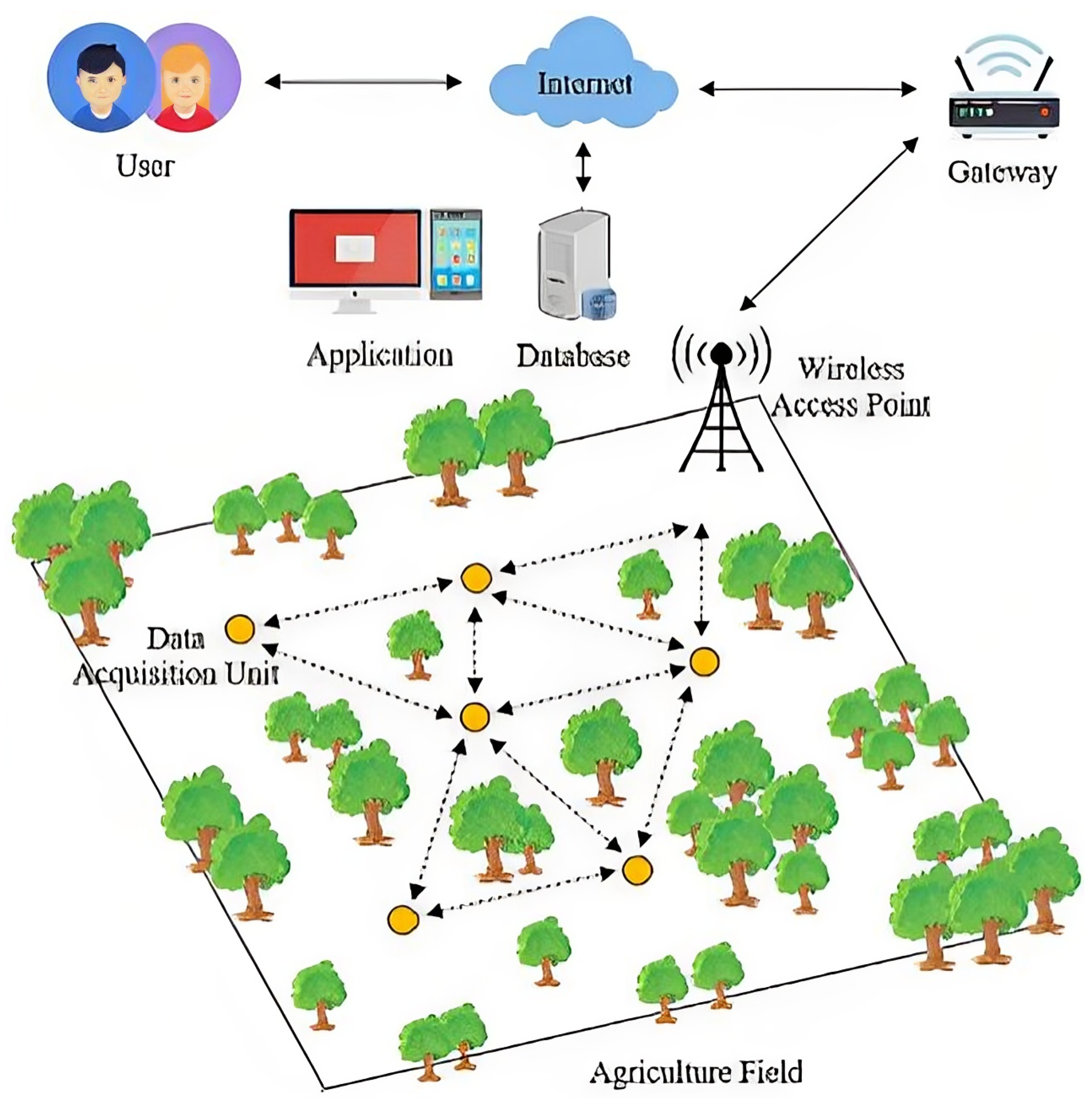
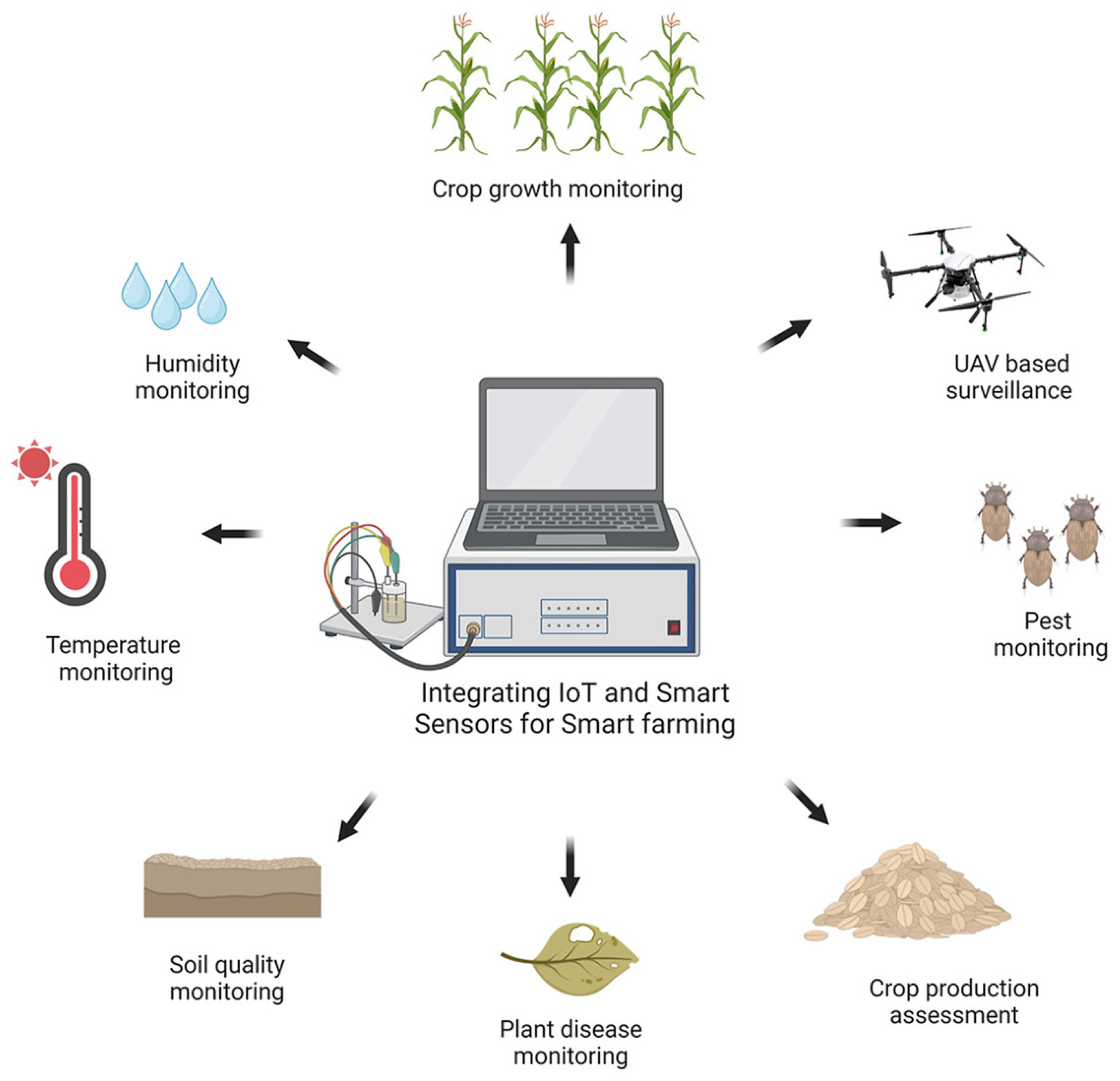
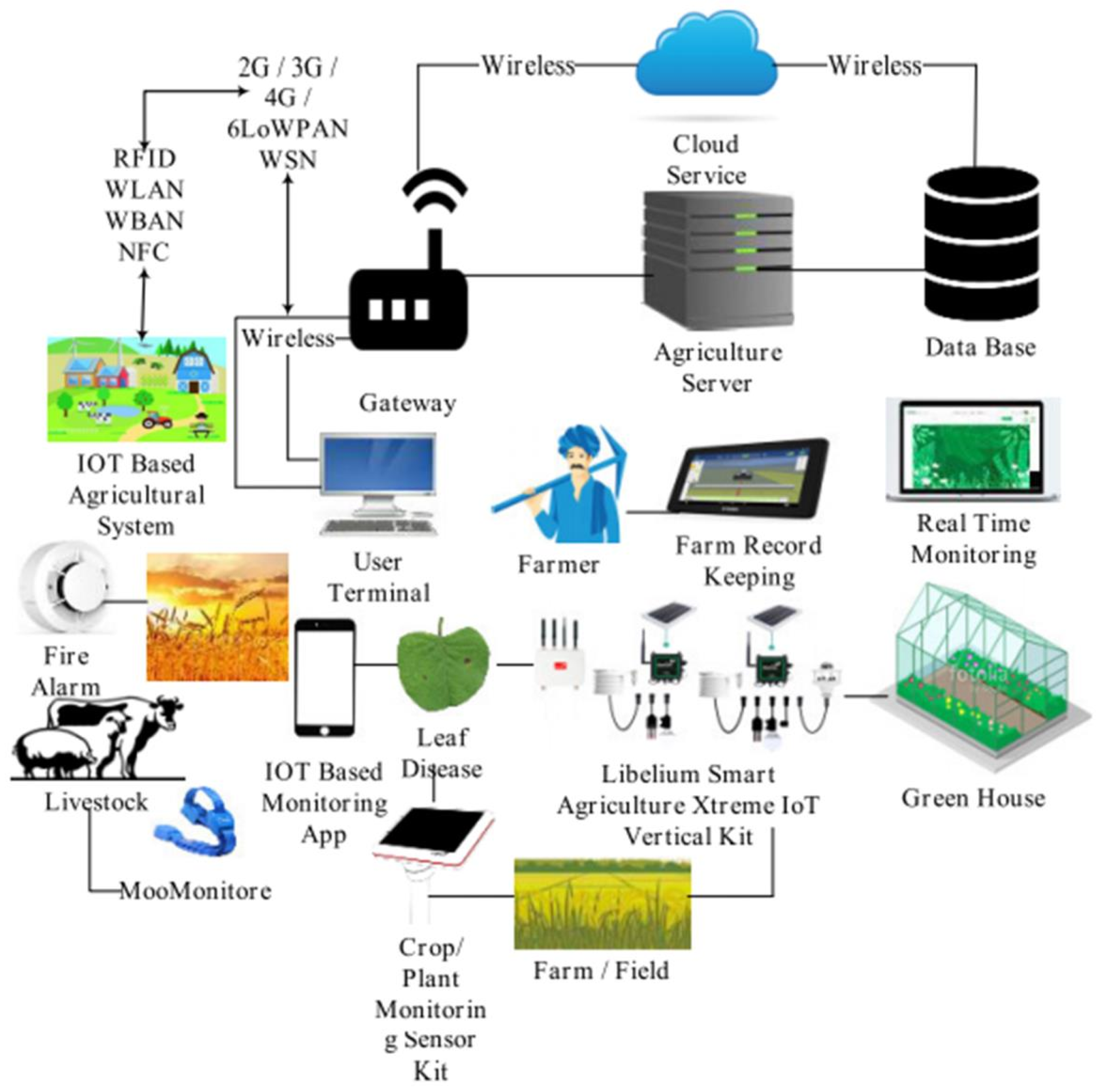

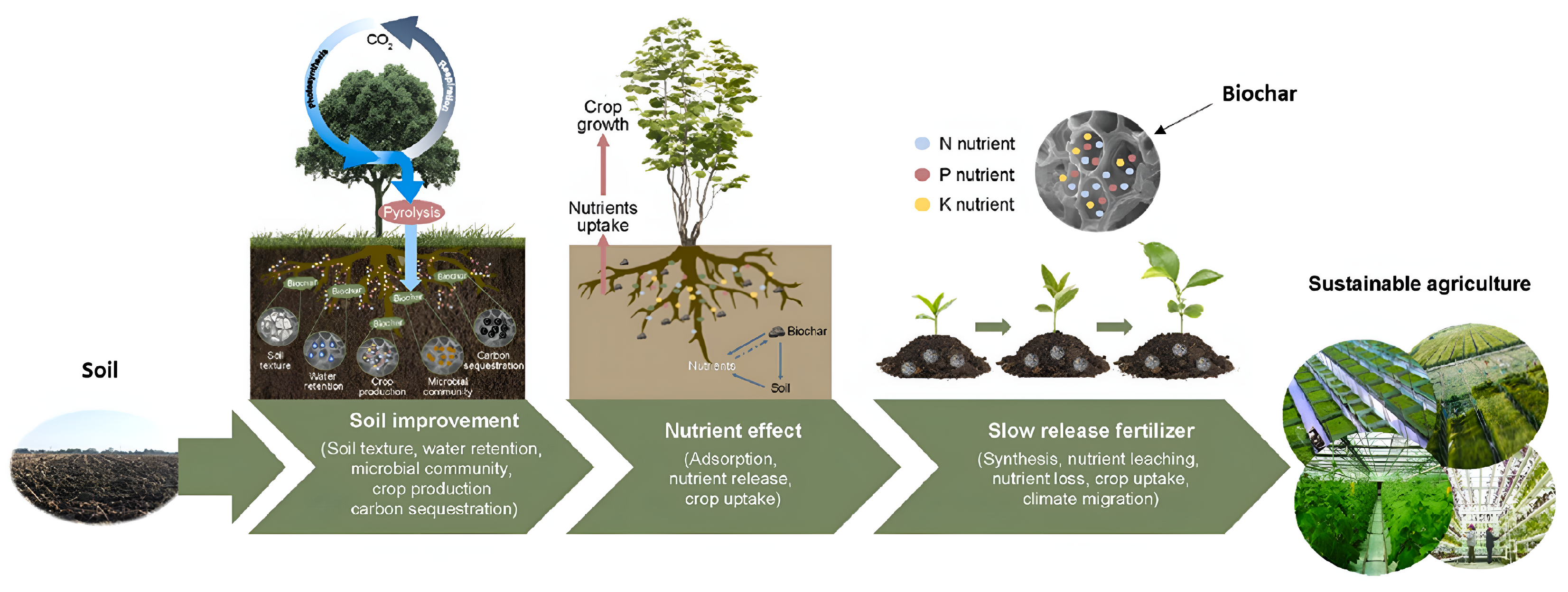
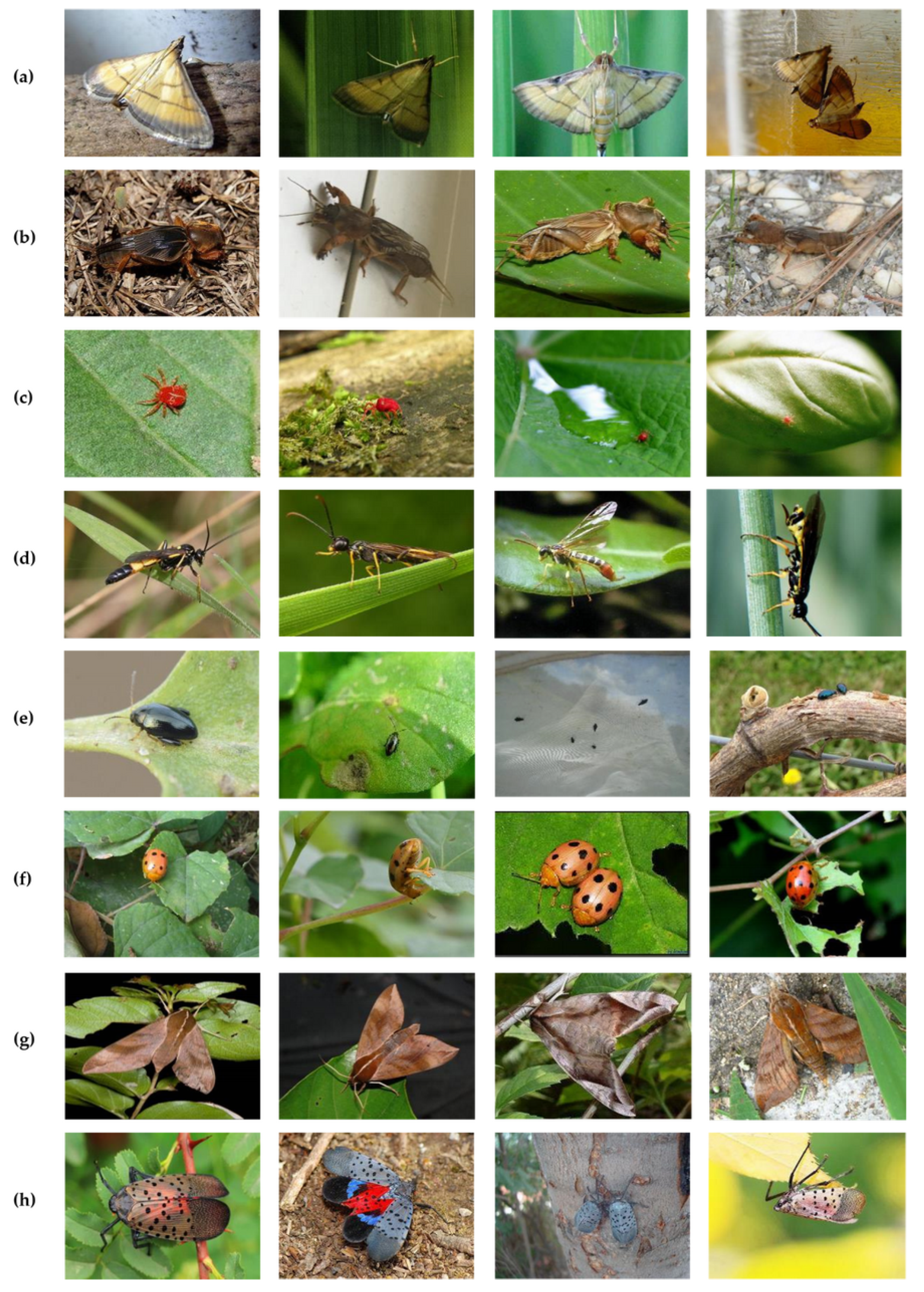
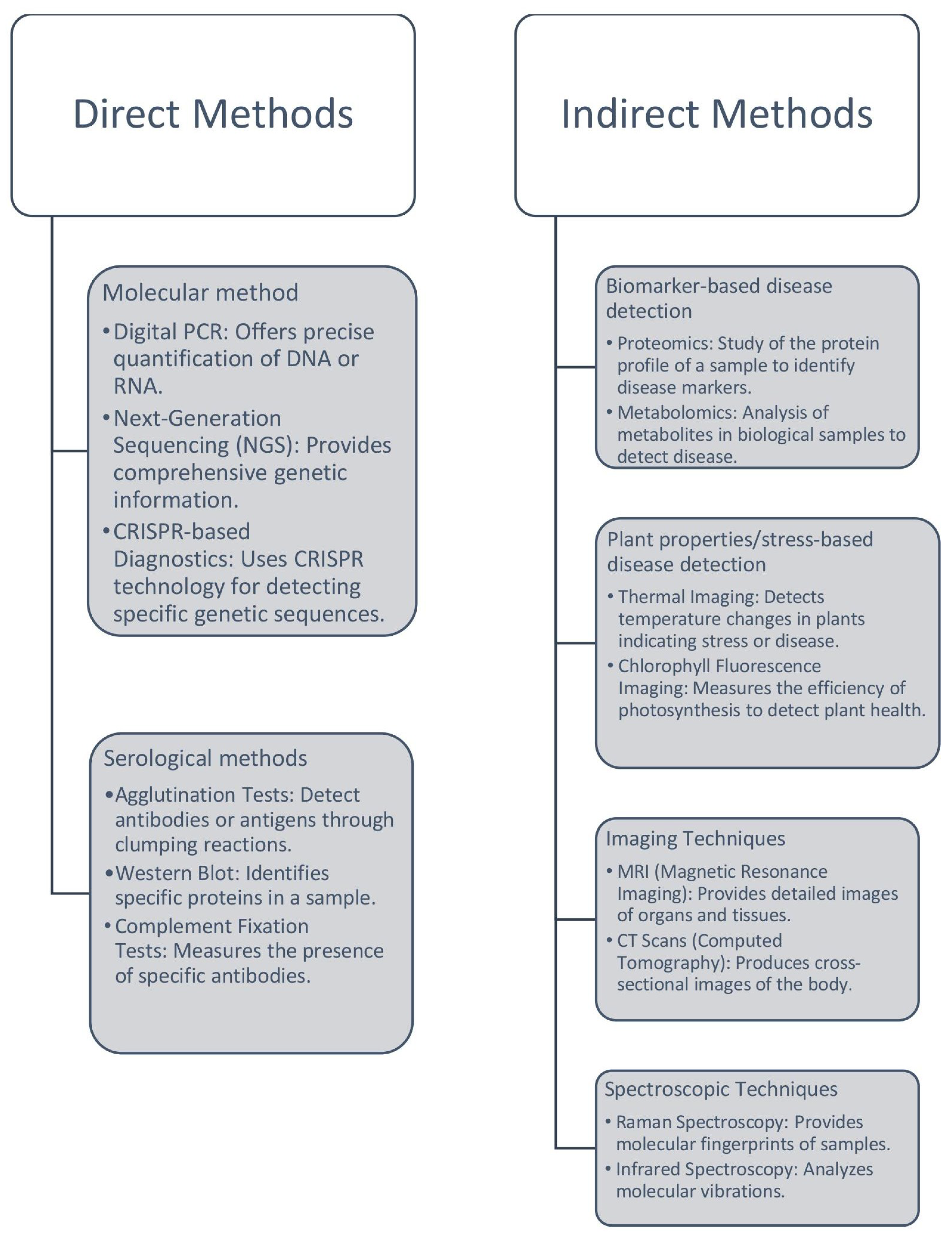
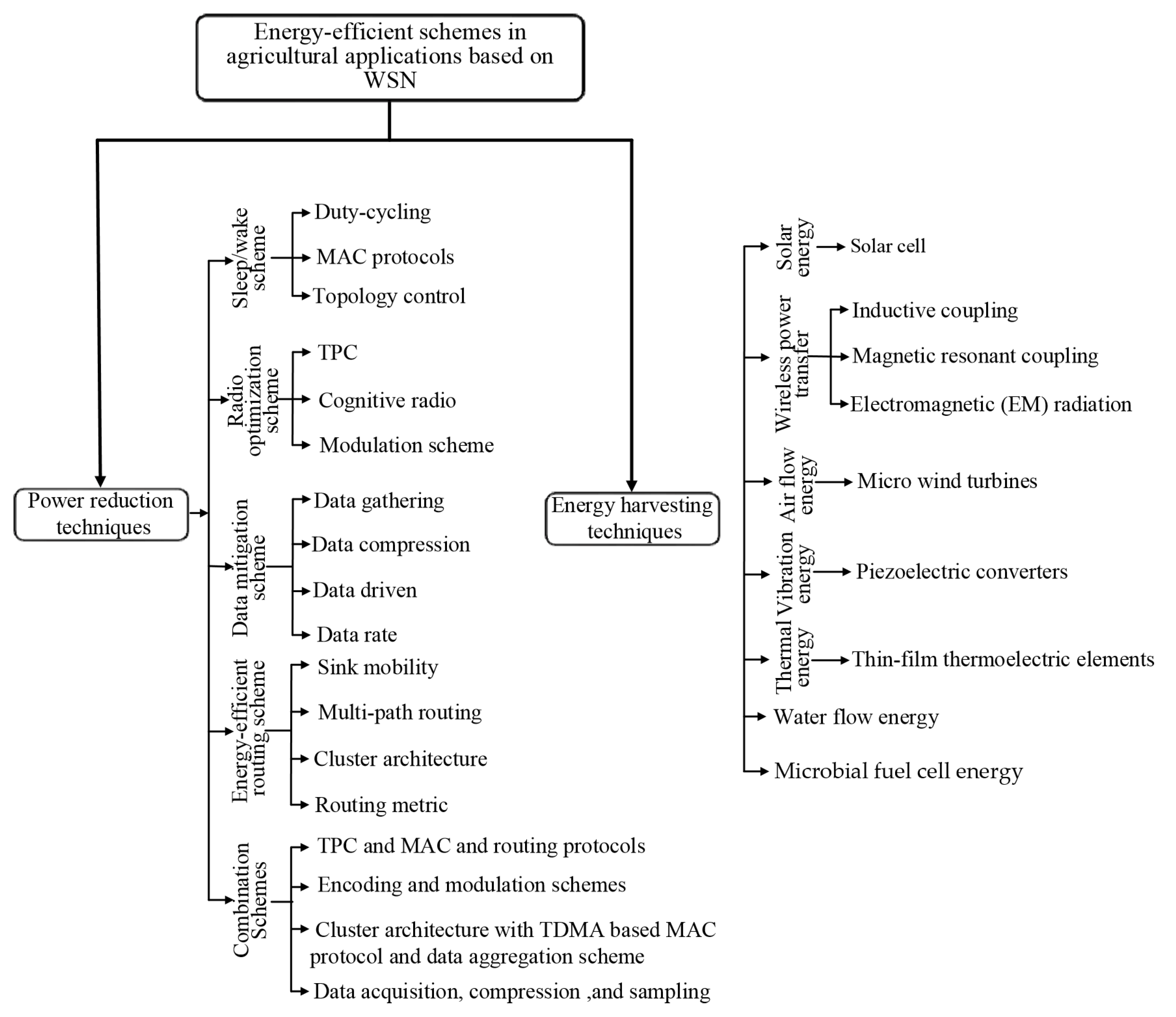
| S/N | Wireless Node | Signaling Rate | Sensing Parameters | Reference |
|---|---|---|---|---|
| 1 | MICA2 | 38.4 K Baud | Sounder, video sensor, accelerometer, GPS | [7] |
| 2 | Cricket | 38.4 K Baud | Temperature, light, pressure, humidity, relative humidity, acoustic, magnetometer | [8] |
| 3 | IRIS | 250 Kbps | Light, pressure, acceleration, magnetic, relative humidity, acoustic, seismic, video sensor | [9] |
| 4 | MICAz | 250 Kbps | Light, video sensor, GPS, relative humidity, humidity, magnetometer, temperature, pressure, accelerometer, acoustic, sounder, microphone | [9] |
| 5 | MICA2DOT | 38.4 K Baud | GPS, relative humidity, light, temperature, humidity, pressure, accelerometer, acoustic | [7] |
| 6 | Imote2 | 250 Kbps | Temperature, light, accelerometer, humidity | [8] |
| Serial No. | Sensor Name | Parameters |
|---|---|---|
| 1 | EC 250, ECH2O | Soil temperature, soil moisture, salinity level of water, conductivity |
| 2 | 107-L, LT-2 M, 100K6A1B, MP406 | Temperature of the plant |
| 3 | H2TM, 237 LWS | Level of CO2, H2 and Temperature, Wetness of the plant |
| 4 | CM1000TM, YSI 6025 | Photosynthesis |
| 5 | LW100, TT4 | Moisture, temperature, wetness of the plant |
| 6 | TPS-2 | Photosynthesis and level of CO2 |
| 7 | Cl-340, PTM-48A | Photosynthesis, moisture, temperature, wetness, H2, CO2 Level of the plant |
| 8 | CM-100, MSO- 70 | Temperature, pressure and humidity of the air, wind speed |
| 9 | HMP45C, Cl-340, XFAM-115KPASR, SHT71, SHT75 | Temperature, pressure and humidity of the air |
| 10 | 107-L AT | Air temperature |
| Communication Protocols | Network Topology | Data Rate | Standard | Power Consumption | Communication Range |
|---|---|---|---|---|---|
| 6LoWPAN Technology | Star, Mesh | 0.3–50 Kbps | IEEE 802.15.4 [24] | Low | 2 to 5 km urban, 15 km sub-urban |
| ZigBee Technology | Star, Mesh, cluster | 250 Kbps | IEEE 802.15.4 [24] | Low | 10 to 100 m 15 km sub-urban |
| Bluetooth Technology | Star, Bus | 1–2 Mbps | IEEE 802.15.1 [25] | Low | 30 m |
| RFID Technology | P2P | 50 tags/s | RFID [26] | Ultra Low | 10 to 20 cm |
| LoRa WAN Technology | P2P, Star | 27–50 Kbps | IEEE 802.11ah [27] | Very Low | 5 to 10 km |
| Wi-Fi Technology | Star | 1–54 Mbps | IEEE 802.11 [28] | Medium | 50 m |
| Serial No. | Parameter | IoT Application | Ref. |
|---|---|---|---|
| 1 | Soil moisture | Precision irrigation | [29] |
| 2 | Temperature | Soil and crop monitoring | [30] |
| 3 | Nutrient levels | Automated fertilization | [6] |
| 4 | Livestock health | Livestock health tracking | [5] |
| 5 | Environmental conditions | Disease prevention | [31] |
| Plant/Crop | Pathogen | Type | Molecular Method(s) | Reference |
|---|---|---|---|---|
| Tomato | Fusarium sambucinum | Fungi | Quantitative PCR (qPCR) | [52] |
| Maize | Fusarium spp. and Magnaporthiopsis maydis | Fungi | Real-time PCR targeting ITS region | [53] |
| Olive | Fungal communities causing leaf spots | Fungi | PCR-based identification | [54] |
| Potato/tomato | Phytophthora infestans | Oomycete | Loop-mediated isothermal amplification (LAMP) | [55] |
| Tomato | Pseudomonas syringae pv. tomato | Bacteria | LAMP targeting hrpZ gene | [56] |
| Various crops | Plant viruses | Virus | PCR, ELISA, next-generation sequencing (NGS) | [57] |
| Imaging Technique | Spectral Range | Resolution | Key Applications | Advantages | Limitations | Ref. |
|---|---|---|---|---|---|---|
| Hyperspectral imaging | 400–2500 nm | <1 nm | Crop health monitoring, soil analysis, water usage | Detailed spectral information, precise monitoring | High cost, complex data processing | [76,77] |
| Multispectral imaging | 400–1000 nm | 10–20 nm | Yield prediction, crop monitoring, field robotics | Cost-effective, rich spectral information | Lower spectral resolution compared to hyperspectral | [78,79] |
| RGB imaging | 400–700 nm | 1–2 nm | Disease detection, plant growth assessment | Cost-effective, widely used | Limited spectral information | [80,81] |
| Sunlight-induced fluorescence | 650–800 nm | <0.5 nm | Photosynthetic activity monitoring, plant health | Accurate photosynthesis estimation, ecosystem monitoring | Requires high spectral resolution | [82,83] |
| Thermal imaging | 8–14 µm | 0.1–0.5 °C | Crop stress detection, irrigation management | Real-time monitoring, detects stress and malfunctions | Sensitive to environmental conditions | [84,85] |
| Techniques | Protocol/Device | Energy/Power Harvesting | Sensors | Ref. |
|---|---|---|---|---|
| Solar cell | ZigBee (XBee-Pro S2) | 240 mW | Temperature of air, soil moisture | [22] |
| RFD 900 | 1.75 to 3 W | Concentration of CH4 and CO2 Concentration | [106] | |
| ZigBee (CC2530) | 500 mW | Humidity of air, temperature of air, shadow detection | [107] | |
| IEEE 802.15.4 | 2 W | pH level, wind direction, temperature of air, humidity of air, wind speed | [108] | |
| C1110 RF module | 500 mW | Humidity of air, camera, temperature of air, leaf wetness | [109] | |
| IEEE 802.15.4 | 1 W | Temperature, condensation system, leaf wetness, rain gauge | [110] | |
| ZigBee (Mica2 motes) | 20 W | Humidity of air, temperature of air, soil moisture, soil temperature | [111] | |
| Inductive coupling | ZigBee | 2.4 W | Temperature of air, vibration, pressure, soil moisture | [112] |
| Magnetic resonant coupling | Not specified | 1315 J | TProcessing of water, environments sensors for agriculture | [113] |
| Wind turbine | Zigbee | 70–100 mW | Ambient temperature of air, rainfall, soil moisture | [114] |
| Piezoelectric convertors | ZigBee (CC2500) | 200 µW | Vibration sensor | [115] |
| Water flow | ZigBee | 16–19 mW | Soil moisture, relative humidity, irrigation control | [116] |
| Microbial fuel cell | LoRa | 296 µW | Irrigation system | [117] |
Disclaimer/Publisher’s Note: The statements, opinions and data contained in all publications are solely those of the individual author(s) and contributor(s) and not of MDPI and/or the editor(s). MDPI and/or the editor(s) disclaim responsibility for any injury to people or property resulting from any ideas, methods, instructions or products referred to in the content. |
© 2025 by the authors. Licensee MDPI, Basel, Switzerland. This article is an open access article distributed under the terms and conditions of the Creative Commons Attribution (CC BY) license (https://creativecommons.org/licenses/by/4.0/).
Share and Cite
Sajib, M.M.H.; Sayem, A.S.M. Innovations in Sensor-Based Systems and Sustainable Energy Solutions for Smart Agriculture: A Review. Encyclopedia 2025, 5, 67. https://doi.org/10.3390/encyclopedia5020067
Sajib MMH, Sayem ASM. Innovations in Sensor-Based Systems and Sustainable Energy Solutions for Smart Agriculture: A Review. Encyclopedia. 2025; 5(2):67. https://doi.org/10.3390/encyclopedia5020067
Chicago/Turabian StyleSajib, Md. Mahadi Hasan, and Abu Sadat Md. Sayem. 2025. "Innovations in Sensor-Based Systems and Sustainable Energy Solutions for Smart Agriculture: A Review" Encyclopedia 5, no. 2: 67. https://doi.org/10.3390/encyclopedia5020067
APA StyleSajib, M. M. H., & Sayem, A. S. M. (2025). Innovations in Sensor-Based Systems and Sustainable Energy Solutions for Smart Agriculture: A Review. Encyclopedia, 5(2), 67. https://doi.org/10.3390/encyclopedia5020067








